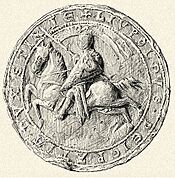Leopold VI, Duke of Austria facts for kids
Quick facts for kids Leopold VI |
|
|---|---|

Seal of Leopold VI
|
|
| Duke of Austria | |
| Reign | 1198–1230 |
| Predecessor | Frederick I |
| Successor | Frederick II |
| Duke of Styria | |
| Reign | 1194–1230 |
| Predecessor | Leopold I |
| Successor | Frederick II |
| Born | 15 October 1176 |
| Died | 28 July 1230 San Germano |
| Burial | Lilienfeld Abbey |
| Spouse | Theodora Angelina |
| Issue |
|
| House | House of Babenberg |
| Father | Leopold V |
| Mother | Helena of Hungary |
Leopold VI (born October 15, 1176 – died July 28, 1230) was an important ruler known as Leopold the Glorious. He was a member of the House of Babenberg, a powerful family in Austria. Leopold ruled as the Duke of Styria starting in 1194 and later became the Duke of Austria in 1198. He held these titles until he passed away in 1230.
Contents
Leopold VI's Life and Rule
Leopold VI was the younger son of Duke Leopold V. His mother was Helena of Hungary. She was the daughter of Géza II of Hungary.
When Leopold V died, his lands were divided. This went against an agreement called the Georgenberg Pact. Leopold VI's older brother, Frederick I, became the Duke of Austria. Leopold VI himself became the Duke of Styria. But Frederick I ruled for only four years. After his death, Leopold VI reunited both duchies under his rule.
Leopold VI was a very active ruler. He took part in the Reconquista in Spain. This was a long series of wars to take back land from Muslim rule. He also joined two crusades. These were religious wars supported by the Church. One was in 1212 and another, the Fifth Crusade, from 1217 to 1221.
Like the rulers before him, Leopold worked to improve his lands. He founded many monasteries. His most important one was Lilienfeld Abbey in Austria. He was buried there after he died. He also supported new religious groups called the Franciscans and Dominicans.
Leopold helped cities grow. He made Enns a city in 1212. He also made Vienna a city in 1221. Vienna's territory almost doubled under his rule.
New Artistic Styles
During Leopold's time, the Gothic style of art and architecture began to arrive in Austria. The Cappella Speciosa was a special chapel in his home at Klosterneuburg. It was one of the first buildings in the Danube area to show this new Gothic style. You can see a copy of it today in the palace gardens of Laxenburg.
A Center for Culture
Leopold's court was a famous place for Minnesang. This was a type of German love poetry and song. Famous poets and singers like Walther von der Vogelweide, Neidhart von Reuental, and Ulrich von Liechtenstein visited his court. Some historians even believe that the famous German epic poem, the Nibelungenlied, might have been written there.
Austria became very important under Leopold's leadership. This was shown by his marriage to Theodora Angelina, a princess from the Byzantine Empire. He also tried to help settle a big disagreement. This was the "War of the Keys" between the Holy Roman Emperor Frederick II and Pope Gregory IX. Leopold was working on this peace effort when he died in 1230 at San Germano.
Leopold's Family
Leopold and his wife, Theodora Angelina, had several children:
- Margaret (born 1204 – died October 29, 1266). She first married Henry, the son of Emperor Frederick II. After Henry died, she married King Ottokar II of Bohemia.
- Agnes of Austria (born February 19, 1205 – died August 29, 1226). She married Albert I, Duke of Saxony.
- Leopold of Austria (born 1207 – died 1216). Sadly, he died young after falling from a tree at Klosterneuburg.
- Henry II, Duke of Mödling (born 1208 – died November 28, 1228). He married Agnes of Thuringia. Their only daughter, Gertrudis, became the main heir of the Babenberg family after her uncle died.
- Gertrude of Austria (born 1210 – died 1241). She married Henry Raspe, Landgrave of Thuringia.
- Frederick II, Duke of Austria (born April 25, 1211 – died June 15, 1246).
- Constantia of Austria (born April 6, 1212 – died June 5, 1243). She married Henry III, Margrave of Meissen.
See also
- List of rulers of Austria
- List of Marshals of Austria

